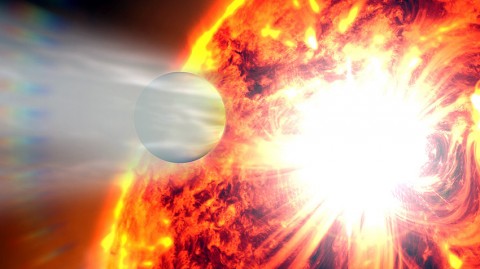NASA’s Goddard Space Flight Center
 Greenbelt, MD – An international team of astronomers using data from NASA’s Hubble Space Telescope has made an unparalleled observation, detecting significant changes in the atmosphere of a planet located beyond our solar system.
Greenbelt, MD – An international team of astronomers using data from NASA’s Hubble Space Telescope has made an unparalleled observation, detecting significant changes in the atmosphere of a planet located beyond our solar system.
The scientists conclude the atmospheric variations occurred in response to a powerful eruption on the planet’s host star, an event observed by NASA’s Swift satellite.

The exoplanet is HD 189733b, a gas giant similar to Jupiter, but about 14 percent larger and more massive. The planet circles its star at a distance of only 3 million miles, or about 30 times closer than Earth’s distance from the sun, and completes an orbit every 2.2 days. Its star, named HD 189733A, is about 80 percent the size and mass of our sun.
Astronomers classify the planet as a “hot Jupiter.” Previous Hubble observations show that the planet’s deep atmosphere reaches a temperature of about 1,900 degrees Fahrenheit (1,030 C).
HD 189733b periodically passes across, or transits, its parent star, and these events give astronomers an opportunity to probe its atmosphere and environment. In a previous study, a group led by Lecavelier des Etangs used Hubble to show that hydrogen gas was escaping from the planet’s upper atmosphere. The finding made HD 189733b only the second-known “evaporating” exoplanet at the time.
“Astronomers have been debating the details of atmospheric evaporation for years, and studying HD 189733b is our best opportunity for understanding the process,” said Vincent Bourrier, a doctoral student at IAP and a team member on the new study.
When HD 189733b transits its star, some of the star’s light passes through the planet’s atmosphere. This interaction imprints information on the composition and motion of the planet’s atmosphere into the star’s light.
In April 2010, the researchers observed a single transit using Hubble’s Space Telescope Imaging Spectrograph (STIS), but they detected no trace of the planet’s atmosphere. Follow-up STIS observations in September 2011 showed a surprising reversal, with striking evidence that a plume of gas was streaming away from the exoplanet.
The researchers determined that at least 1,000 tons of gas was leaving the planet’s atmosphere every second. The hydrogen atoms were racing away at speeds greater than 300,000 mph. The findings will appear in an upcoming issue of the journal Astronomy & Astrophysics.
“The planet’s close proximity to the star means it was struck by a blast of X-rays tens of thousands of times stronger than the Earth suffers even during an X-class solar flare, the strongest category,” said co-author Peter Wheatley, a physicist at the University of Warwick in England.
After accounting for the planet’s enormous size, the team notes that HD 189733b encountered about 3 million times as many X-rays as Earth receives from a solar flare at the threshold of the X class.
Hubble is a project of international cooperation between NASA and the European Space Agency. Swift is operated in collaboration with several U.S. institutions and partners in the United Kingdom, Italy, Germany and Japan. NASA’s Goddard Space Flight Center in Greenbelt, MD, manages both missions.
For more information about Swift, visit: www.nasa.gov/swift
For more information about Hubble, visit: www.nasa.gov/hubble


